- Submissions

Full Text
Research in Medical & Engineering Sciences
Factors Influencing Performance of Poultry Farms in Umuagwo, Ohaji-Egbema Local Government Area of Imo State, Nigeria
Ahaotu EO1*, Okoro CN2, Simeon Ahaotu VC3 and Ezeafulukwe CF4
1Department of Animal Science, University of Agriculture and Environmental Sciences Umuagwo, Nigeria
2Department of Cooperative Economics Technology, Imo State Polytechnic Omuma, Nigeria
3Department of Microbiology, Gregory University Uturu, Nigeria
4Department of Fisheries and Aquaculture Technology, Federal University of Technology Owerri, Nigeria
*Corresponding author:Ahaotu EO, Department of Animal Science, University of Agriculture and Environmental Sciences Umuagwo, Imo State, Nigeria
Submission: June 15, 2023Published: July 17, 2023

ISSN: 2576-8816Volume10 Issue3
Abstract
The purpose of the study was to investigate the factors influencing the performance of poultry farms in Umuagwo community, Imo State, Nigeria. The objectives of the study were to determine influences of product market, level of education of the farmer and the cost of inputs on poultry farms. Basic assumptions of study were that all the respondents would be cooperative and provide reliable responses through the questionnaire given to them. Descriptive survey design was used since the target population is distributed within the section of the locality. The study targeted the poultry farmers whose population was estimated to be 85 and five extension staff officers. The sample size was 30% of the target population. The data and the information from respondents were gathered by use of a questionnaire. The significance was to help the farmer understand the relationship between project growth and training, education, cost of inputs and market.
Keywords:Performance of poultry; Product market; Level of education; Cost of inputs
Introduction
The structure of poultry production changes on a daily basis. Gueye [1] stated that massive changes taking place in the livestock sector cover the complex trends, processes and effects that characterize global livestock demand and supply. The growth in demand for meat and livestock products is tremendous due to population growth, urbanization, changing diets and reductions in the relative prices of livestock products [2].
The high feed cost and new emerging diseases have been the major challenges in the poultry industry [3,4], while the problems faced by industry are: feed cost, ignorance regarding biosecurity, egg and broiler fluctuating rates [5]. Apart from high cost of poultry feed in Nigeria, local and scavenger chicken producers still faced challenges on how to implement bio-security measures on scavenging poultry especially in the face of resurging H5N1 Virus and other emerging diseases [6].
Factors that affect marketing of local poultry include seasonal availability of birds, transportation, retailer output, outbreaks of diseases, lack of information on prices and streamlined marketing structures. A major constraint to small-scale, family-based poultry production is Newcastle disease which is caused by a virus that is capable of causing up to 80 to 100% mortality in unprotected flocks [7]. The virus spreads rapidly by means of airborne droplets produced by the coughing of infected birds. The highest prevalence of Newcastle disease outbreaks occurs in the dry season, from November to March [8].
Training in disease diagnosis, epidemiology, environmental health and disease prevention must be provided, not only for health personnel, but for the farmers as well. Limited access to institutional services such as extension, training, credit and veterinary services affect poultry production in Nigeria [9]. This study investigated the factors influencing the performance of poultry farming projects in Umuagwo, Ohaji Egbema Local Government Area of Imo State, Nigeria
Material and Methods
This study was conducted in Umuagwo in Ohaji - Egbema Local Government Area of Imo State, Nigeria. The site is situated between longitudes 7° 01 0611E and 7o 031 0011 and latitudes 5o 281 0011N and 5o 301 0011N in the humid tropical West Africa. It also has an annual rainfall of 2000mm-2484mm and average temperature of 26 °C [10]. The study was done using a descriptive survey design which investigated the prospects of revitalizing the performance of poultry projects among the poultry farmers in Umuagwo, Ohaji -Egbema Local Government Area of Imo State, Nigeria.
Descriptive survey was used in preliminary and exploratory studies to allow researchers gather information, summarize, present and interpret for the purpose of clarification. In this study, the target population was the poultry farmers in Umuagwo, Ohaji-Egbema Local Government Area of Imo State, Nigeria whose population was estimated to be 302 commercial poultry farmers, 5 extensions staff members.
The sample used in the study was made up of 85 farmers and 5 extension staff members. The respondents were selected randomly. The study targeted commercial poultry farmers and extension officers in the three communities in Umuagwo, Ohaji Egbema Local Government Area of Imo State, Nigeria. Two types of data were used: one for the poultry farmers and the other for extension ‘staff in the field. The questionnaire, which is a tool with a list of questions, to which respondents were required to respond to, was taken by the researcher to the selected farmers and extension staff. Questionnaires are more objective because they gather responses from the subject matter. The researcher collected the primary data using a structured questionnaire. The researcher dropped and picked the questionnaires from the sampled poultry farmers.
Result and Discussion
The researcher administered ninety-three (93) questionnaires to randomly selected farmers in the three communities in Umuagwo, Ohaji Egbema Local Government Area of Imo State, Nigeria namely: Umuelem, Mboke and Umuezeawula. 85 questionnaires were returned duly filled, representing a response rate of 9l%.
The result showed that there are more men, 60%. Fifty one out of 85 as compared to women 38.8%, thirty three out of 85 who practiced poultry farming as a project in Umuagwo (Table 1).
Table 1:Gender of the respondents.

The results showed that the majority (4l.2%), thirty five out of 85 of the poultry projects farmers are middle aged adults at (36- 45) years, followed by young adults of (26-35) years at 26% while twenty two out of 85 who are energetic. Older farmers over 55 years age and young adult at (l 8-25) years are quite few representing only 4% and 7% respectively (Table 2).
Table 2:Age of the respondents.
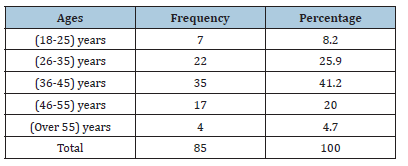
The table showed that the poultry projects are relatively new in Umuagwo, since the majority of the respondents (49.6%) 42 out of 85 have been in it for I - 3 years while only 17% 15 out of 85 have practiced for a longer time of over 6 years (Table 3).
Table 3:Years of involvement by the project farmers.
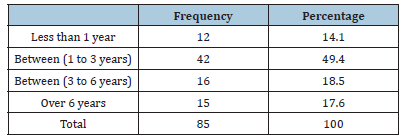
It was evident that the majority (69.4%) 59 out of 85 of the poultry project farmers in Umuagwo community kept layers for eggs production while quite a few (47%) 4 out of 85 keep broilers for meat. The rest kept the general-purpose birds l2.9%, l1 out of 85 and a mixture of layers and broilers at an equal level of l2.9% (Table 4).
Table 4:Types of birds.
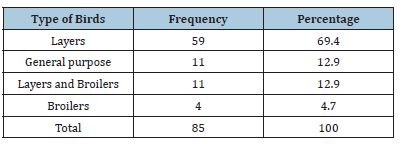
The majority, 37% (32 out of 85) of the farmers operate at little profits level and about 80% and a frequency of 68 in 85 do not realize high or good performance from their projects in Umuagwo community. Starters referred to the relatively new farmers who are yet to reach the marketing stage. The performance was measured in terms of percentage laid by layers which are the bulk of the birds reared as shown in Table 5. Broilers are sold at maturity and therefore the performance depends on the market price. The researcher focused on layer birds. The poor and losses category were those farmers whose records of percentage is below 60%. This is possible because the production cost of poultry was at least 60% of the income from egg sales. This was agreed on by all the farmers since the feeds are commercially manufactured for commercial birds. Low profit levels are those whose (61-70) % of their birds lay. After ploughing back up to 60% into the feeds and other expenses, little remains, hence low profit. Fair performance was those whose record of their hens lay was (71-80) %. High performances were those operating above 80% of birds laying. It was evident from Table 6 that only 14%, 12 out of 85 of the respondents could not pass through secondary school education. Majority 86%, 73 out of 85 have at least formed four levels of education.
Table 5:Performance of poultry.
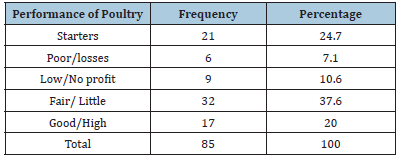
Table 6:Level of education.
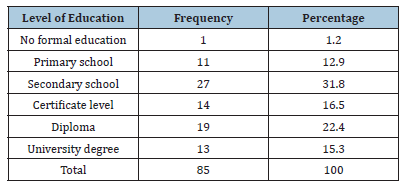
In agriculture, education is a key determinant of technology adoption and education levels are highly correlated with technology adoption rates. This in turn increases agricultural productivity, incomes and improved livelihoods [11]. In Table 7 above, the highest mean, 85%, of performance occurred among the University degree holder farmers, followed by the Diploma holder farmers at 80% and the rest, secondary, primary and non-formal levels do below 80%.
Table 7:Ratio of eggs to hens in percentage versus level of education.

From Table 8 above, the overwhelming majority, 88%, 75 out of 85 agreed that the project inputs are expensive. Very few 3.5%, 3 out of 85 disagreed with the high cost of inputs.
Table 8:Cost of inputs.

Conclusion
Poultry projects are important sources of employment. Poultry farmers did the work of keeping the birds, raising capital and carried out the marketing of the products. The success of the business will solve the prevalent unemployment situation in Umuagwo community, Imo State, Nigeria.
The high cost of inputs, particularly the feeds, closes out many would be investors in this field and curtails the income and benefits that would accrue to the practicing farmers. This shrinks the scale of operations to bear minimum and therefore falls short of enjoying economies of scale. Education to the farmer is paramount as indicated by the good performance of those with a high level of education.
Recommendation
The governments have the leading roles to play in creating an enabling environment for the poultry farmers. The appropriate policy framework could exist as in taxation to relief the farmers of high cost of inputs to cushion part of the cost. There must be mechanisms to ensure that this becomes a reality for the farmer in the ground.
A more serious investment should be made in the provision of extension services together with both human and physicals resources. A suitable ratio of extension officers to farmers should be determined and actualized. At the state level, it is worth considering incorporating private veterinarians in the prevision of service to the farmers. Giving the subsidy and mobilizing them to serve a particular area at a time will increase service availability and reduce the high cost borne by the farmers. The government should also invest in the provision of access roads to all comers as this will reduce the cost of transport, encourage more investments in poultry.
References
- Gueye EF (2003) Poverty alleviation, food security and the well-being of the human population through family poultry in low-income food-deficit countries. Journal of Food Agriculture and Environment 1(2): 12-21.
- Nwanta JA, Abdu PA, Ezema WS (2008) Epidemiology, challenges and prospects for control of Newcastle disease in village poultry in Nigeria. World's Poultry Science Journal 64(1): 119-127.
- Oladele OI (2004) Livestock farmers' awareness, access and benefits of veterinary extension services in Southwestern, Nigeria. Livestock Research for Rural Development 16(6).
- Ahaotu EO, Nwabueze E, Azubuike AP, Anyaegbu F (2020a) Study on the anti- microbial and anti-inflammatory properties of True Frangipani (Plumeria rubra) for the prevention and treatment of diseases in animal agriculture. Annals of Applied Microbiology and Biotechnology Journal 4(8): 1-8.
- Aboki E, Jongur AAU, Onu JI (2013) Productivity and technical efficiency of family poultry production in Kurmi local Government Area of Taraba State, Nigeria. Journal of Agriculture and Sustainability 4(1): 52-66.
- Ahaotu EO, Adeyeye SA, Olueze CC, Akunna TO, Akinfemi A (2020b) Benefits and widespread of external parasites infestation in indigenous chickens (Gallus Gallus Domesticus) a study from randomized states in Nigeria. Journal of Veterinary and Marine Sciences 2(3): 107-115.
- Toluwase SOW, Akpata OM (2013) Impact of farmer’s cooperatives on agricultural productivity in Ekiti State, Nigeria. Greener Journal of Agricultural Sciences 3(1): 63-67.
- Ahaotu EO, Agbasu CA (2015) Evaluation of the stocking rate on growth performance, carcass traits and meat quality of male Peking ducks. Scientific Journal of Biological Sciences 4(3): 23-29.
- Nnadi GL, Simeon Ahaotu VC, De los Ríos Escalante P, Ahaotu EO (2021) Replacement level of rubber seed cake for soybean meal on the growth of Japanese quail. Brazilian Journal of Biology 82: e243242.
- Imo State Ministry of Lands and Survey (IMLS) (2015) Longitudes and Latitudes locations of Umuagwo, Ohaji / Egbema Local Government Area of Imo State, Nigeria.
- ThankGod C (2022) Factors influencing performance of poultry farms in Umuagwo, Ohaji - Egbema Local Government Area of Imo State, Nigeria. Student Project, Department of Animal Production and Health Technology, Imo State Polytechnic Omuma, Oru East, Nigeria, p. 66.
© 2023 Ahaotu EO. This is an open access article distributed under the terms of the Creative Commons Attribution License , which permits unrestricted use, distribution, and build upon your work non-commercially.
 a Creative Commons Attribution 4.0 International License. Based on a work at www.crimsonpublishers.com.
Best viewed in
a Creative Commons Attribution 4.0 International License. Based on a work at www.crimsonpublishers.com.
Best viewed in 







.jpg)






























 Editorial Board Registrations
Editorial Board Registrations Submit your Article
Submit your Article Refer a Friend
Refer a Friend Advertise With Us
Advertise With Us
.jpg)






.jpg)














.bmp)
.jpg)
.png)
.jpg)










.jpg)






.png)

.png)



.png)






